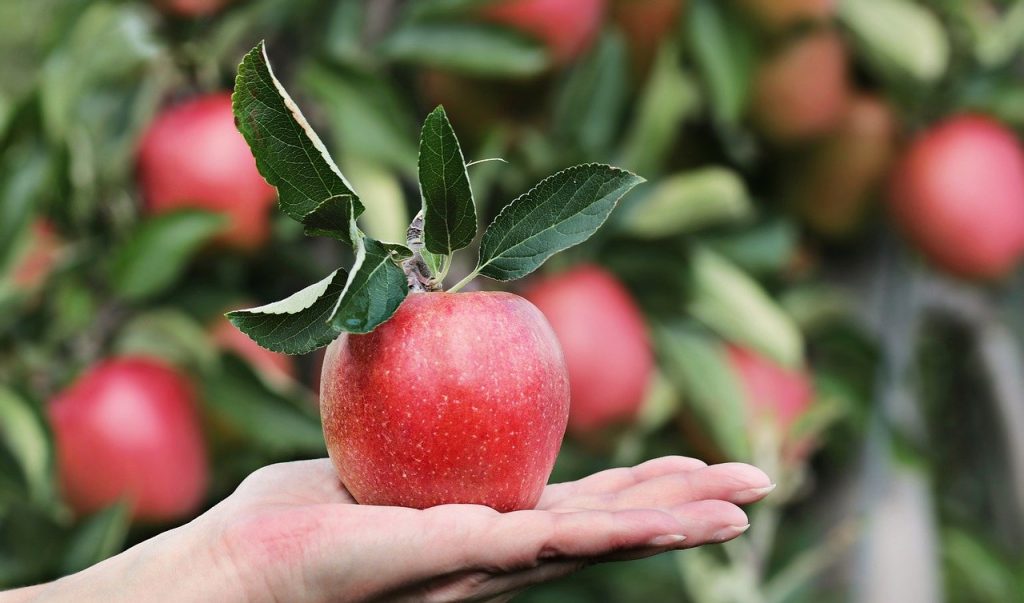[Article updated on 19/09/2023]
Apples are one of the most popular fruits. We eat them all year round. They are delicious raw, but you can also make delicious apple pies or pancake mousse with them. Apples are relatively inexpensive. You can buy them at any store and it’s easy to take them with you. Just one question: how many calories are in an apple? Can we eat them on a slimming diet with complete impunity?
How many calories are in an apple?
Apples are not high in calories because, like most fruits, they contain more than 80% water. 100 grams (or about half a piece) contain 52 kcal, 12 g of carbohydrates (including 5.4 g of fructose), 2.4 g of fiber, 0.4 g of protein and 0.4 g of fat. So, a small apple (around 75 grams) will have around 35 calories. A large apple weighing around 180 grams only provides around 100 kcal.

A kind of alternative to raw apples is baked and boiled apples. They can be a healthy snack for dieters and children. 100 grams of baked or cooked apples contain 90-100 kcal, and the amount can change significantly with the addition of any additives. It is also worth remembering that a heat-treated apple will contain much less fiber, vitamins and some minerals.
Dried apples are a much healthier alternative to baked apples. They are particularly recommended in the diet of people who practice sports intensively. 100 grams of dried apples have an energy value of approximately 240 kcals. A standard 25 gram serving of apple chips contains almost 60 kcals.
Nutrient content of apple
Whole, unpeeled apples are a rich source (per 100 g of fruit):
- fiber (2.4 g);
- carbohydrates (nearly 14 g);
- vitamin C (4.6 mg);
- thiamine (0.017 mg);
- vitamin A (54 IU);
- vitamin E (about 0.2 mg);
- riboflavin (0.026);
- calcium (6 mg);
- potassium (106 mg);
- phosphorus (11 mg);
- magnesium (5 mg).
Most of these substances are contained in the skin and alveoli. The best solution is therefore to eat the whole apple, unpeeled. The reduction in pectin amounts is also caused by heat treatment. That is why the consumption of raw apples is especially important for people struggling with unnecessary kilograms.
Apple nutritional value table
| Nutrients | Apple: content per 100 grams |
| Carbohydrates | 13.8g |
| -with sugar | 10.4g |
| – starch | 0.05g |
| – dietary fiber | 2.4g |
| Proteins | 0.26g |
| Lipids | 0.17g |
| -including cholesterol | 0 mg |
| -of which saturates | 0.028g |
| Potassium | 107 mg |
| Sodium | 1mg |
| Water | 85.6g |
How much does an apple weigh on average?
A medium-sized apple weighs around 170g and provides 71 calories. The amount of calories from a medium-sized apple is similar to the amount of calories from, say, a slice of cheese, a glass of milk, or 6.5 teaspoons of sugar.
To burn these calories (100 kcal), you must, for example, cycle for at least 18 minutes, swim for 15 minutes or run for 13 minutes. The calories in an apple come from 2% protein, 96% carbohydrates and 3% fat.
Do apples make you fat?
Despite the high content of simple sugars, such as glucose, fructose and sucrose, their glycemic index remains low due to the presence of fiber. These fibers are mainly represented by pectins, which are soluble fibers, that is to say capable of dissolving in water. Once in the intestine, they form a gelatinous mass capable of preventing the absorption of excess lipids, sugars and other substances. According to research results, consuming 120 grams of apple before a meal can increase the feeling of fullness.
These fibers are also capable of regulating intestinal peristalsis, becoming useful both in cases of diarrhea and constipation. Given their low calorie content and the properties just mentioned, apples are therefore valid allies for weight loss if they are included in a balanced low-calorie diet.
They can be consumed by diabetics. In addition, given their versatility, they can be used in sweet and savory dishes as well as in the diet of vegetarians and vegans. Therefore, it can be said that apples do not make you gain weight but. On the contrary, they can help you lose weight. So it is worth including apple in your daily diet, especially in your diet.
Beneficial properties of apples
Eaten raw or cooked, the apple regulates intestinal functions, thanks to its high fiber content. Consumed raw, it has an anti-diarrheal effect thanks to the astringent action of the acids.
Since it contains very little fat and sugar, it is a perfect food for those who want to keep in shape. Indeed, it has very few calories but keeps you satisfied for a long time. It is also very useful for diabetics, because the fructose contained in apples is metabolized without the use of insulin. In addition, it prevents stomach bloating.
Apples are full of substances, called polyphenols, which counteract the action of free radicals in the body, which cause cellular aging. In addition, it also has the advantage of lowering blood cholesterol levels thanks to pectin.
The beneficial action of apples also extends to the area of cancer prevention, thanks to the content of flavonoids and vitamin C. These compounds thus combat tissue damage due to free radicals.
